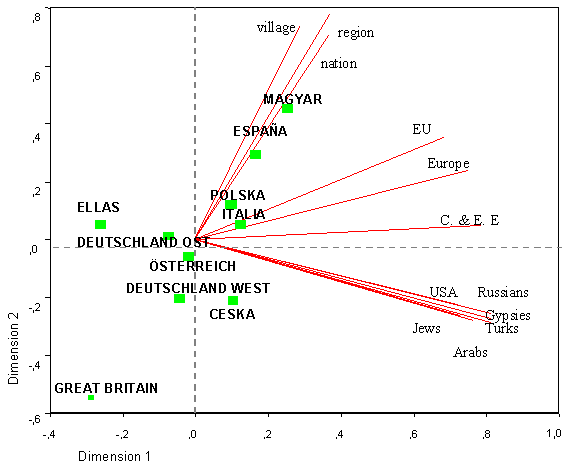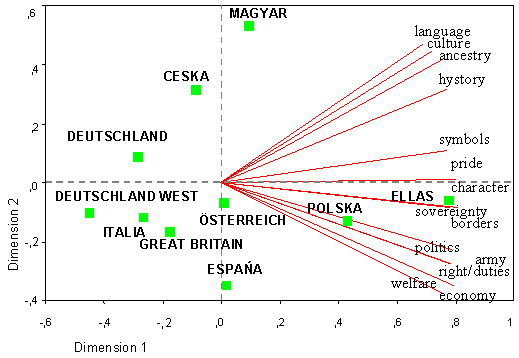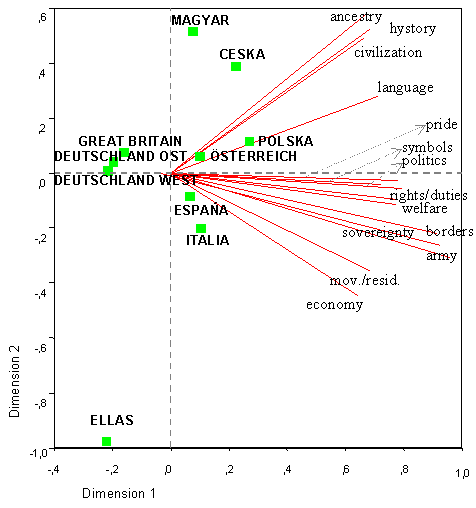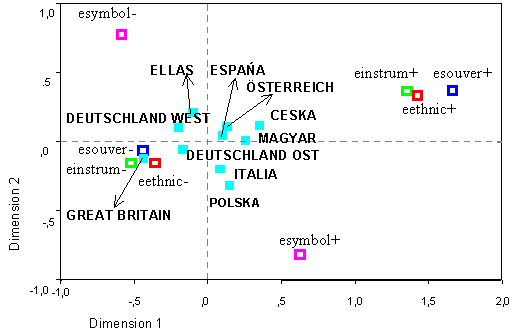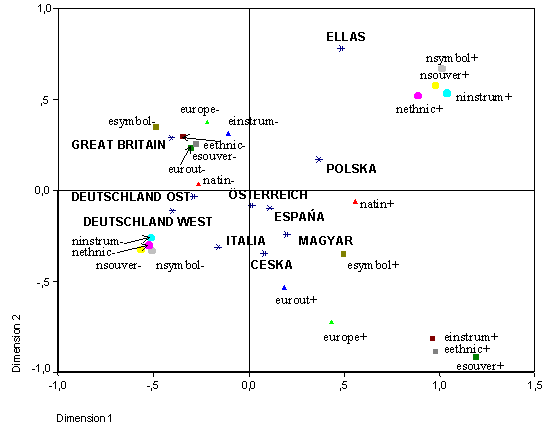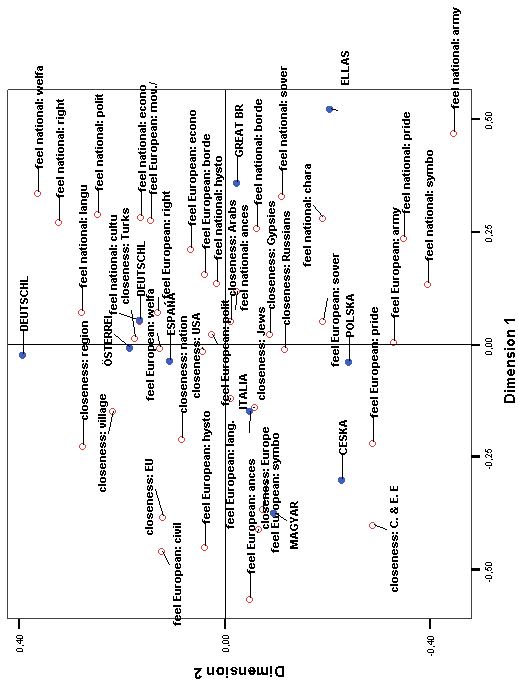| Country | Institution | Start -
End fieldwork |
Net sample size |
EU
population aged 15+ (x 000) |
| Belgium | INRA BELGIUM | 30/04 - 30/05 | 1049 | 8,326 |
| Denmark | GfK DANMARK | 27/04 - 10/06 | 1001 | 4,338 |
| Germany (East) | INRA DEUTSCHLAND | 03/05 - 23/05 | 1023 | 13,028 |
| Germany (West) | INRA DEUTSCHLAND | 02/05 - 23/05 | 1016 | 55,782 |
| Greece | MARKET ANALYSIS | 11/05 - 10/06 | 1002 | 8,793 |
| Spain | INRA ESPAÑA | 06/05 - 25/05 | 1000 | 33,024 |
| France | CSA-TMO | 10/05 - 03/06 | 1007 | 46,945 |
| Ireland | LANSDOWNE Market Research | 01/05 - 10/06 | 991 | 2,980 |
| Italy | INRA Demoskopea | 04/05 - 27/05 | 1002 | 49,017 |
| Luxembourg | ILRes | 07/05 - 07/06 | 600 | 364 |
| The Netherlands | INTOMART | 08/05 - 10/06 | 1014 | 12,705 |
| Austria | SPECTRA | 02/05 - 23/05 | 1018 | 6,668 |
| Portugal | METRIS | 04/05 - 14/05 | 1000 | 8,217 |
| Finland | MDC MARKETING RESEARCH | 07/05 - 04/06 | 1005 | 4,165 |
| Sweden | GfK SVERIGE | 01/05 - 09/06 | 1000 | 7,183 |
| Great Britain | MARTIN HAMBLIN LTD | 30/04 - 30/05 | 1038 | 46,077 |
| Northern Ireland | ULSTER MARKETING SURVEYS | 06/05 - 24/05 | 314 | 1,273 |
| Czech Republic | INRA PRAHA | 16/05 - 31/05 | 1013 | 7,618 |
| Hungary | INRA HUNGARY | 10/05 - 23/05 | 1027 | 8,970 |
| Poland | IQS and QUANT Group | 20/05 - 30/05 | 1000 | 28,866 |
| Total Number of Interviews | 16,080 | 308,885 | ||
| Percentage very close | Percentage very close + close | |||
| 1995(b) | 2002 | 1995(b) | 2002 | |
| Germany W | 24,2 | 26,1 | 79 | 80,7 |
| Germany E | 27,7 | 29 | 81,3 | 73,5 |
| Austria | 56,1 | 30,9 | 90,8 | 81,3 |
| Great Britain | 24 | 14,1 | 70 | 78,6 |
| Italy | 42,9 | 38,9 | 70,6 | 87,8 |
| Spain | 42,7 | 45,8 | 89,5 | 89,4 |
| Greece | 46,8 | 84,9 | ||
| Hungary | 79,6 | 65,9 | 96,4 | 96,8 |
| Poland | 54,6 | 42,7 | 93,9 | 93,8 |
| Czech R. | 47,5 | 28,4 | 91,7 | 71,8 |
SOURCES: ISSP 1995 - National Identity (ZA-No. 2880), Standard Eurobarometer 57.2 (2002).
(a) Countries are unweighted.
(b) The question asked in 1995 was "How close do you feel to (R's country)?" The participants responded to this question on a 4-point Likert-type scale (1 = very close; 2 = close; 3 = not very close; 4 = not close at all; 8 = can't choose, don't know; 9 = NA, refused).
| Percentage very close | Percentage very close + close | |||||
| C_1995(b) | E_2002(c) | EU_2002(d) | C_1995(b) | E_2002(c) | EU_2002(d) | |
| Germany W | 11,9 | 4 | 5,4 | 58,8 | 30 | 40,8 |
| Germany E | 12,2 | 3 | 4,4 | 59,1 | 29,3 | 38,7 |
| Austria | 27,3 | 5,5 | 7,8 | 68,6 | 32,4 | 43,3 |
| Great Britain | 4,2 | 1,8 | 3 | 21,3 | 19,4 | 27,2 |
| Italy | 23 | 4,2 | 10,5 | 69 | 43,5 | 58 |
| Spain | 20,5 | 8,1 | 62,3 | 40,5 | 56,4 | |
| Greece | 5,2 | 7,8 | 27,8 | 35,2 | ||
| Hungary | 75,7 | 9,7 | 14,9 | 94,3 | 45,8 | 42 |
| Poland | 29 | 5,2 | 6,6 | 70,7 | 37,1 | 43,3 |
| Czech R. | 30,1 | 4,9 | 4,8 | 80,5 | 43,2 | 45,4 |
SOURCES: ISSP 1995 - National Identity (ZA-No. 2880), Standard Eurobarometer 57.2 (2002).
(a) Countries are unweighted.
(b) The question asked in 1995 was "How close do you feel to (R's relevant continent of subcontinent)?" The participants responded to this question on a 4-point Likert-type scale (1 = very close; 2 = close; 3 = not very close; 4 = not close at all; 8 = can't choose, don't know; 9 = NA, refused). Since this question is not coincident with those asked in the Standard Eurobarometer 57.2, we have considered two possibilities:
(c) Closeness to European Union citizens
(d) Closeness to fellow Europeans (including European Union citizens and people living in countries that are part of the European continent but which may not form part of the European Union)
| Percentage of population with
dual identity: national and European (a) |
Net percentage of population
with dual identities (national and European) (b) |
Comparative attachment to
national and European identities (c) |
|
| GERMANY WEST | 47 | -6 | .715 |
| GERMANY EAST | 45 | -10 | .792 |
| AUSTRIA | 51 | 2 | .689 |
| GREAT BRITAIN | 36 | -28 | .758 |
| ITALY | 64 | 28 | .669 |
| SPAIN | 61 | 22 | .718 |
| GREECE | 40 | -20 | 1.099 |
| HUNGARY | 54 | 8 | 1.043 |
| POLAND | 46 | -8 | 1.012 |
| CZECH REPUBLIC | 54 | 8 | .748 |
(a) Computed from contingency table. This is the percentage of those who are very close or quite close to their nation and who simultaneously feel very close or quite close to the EU.
(b) Computed from contingency table. This is the percentage of the population with dual identities (they very close or close both to their nation and the EU) minus the percentage of population with only national identity (very close or close to their countries but not very, or not at all, close to the EU). A negative value indicate that most of the of the population in the country hold only national identities. A positive value indicates that the percentage of those with dual identities outnumbers the percentage of population with only national identification.
(c) Independently of the percentage of the population holding only national or dual identities, this column measures the relative strength of attachment to both identities. It is the median value of substracting median identification with the EU from median identification with the nation. A positive value indicates that attachment to the nation is stronger than attachment to the EU (that is closeness to the nation is closer).
| GERMANY EAST | GERMANY WEST | ||||
| Five most important for nation |
Five most important for Europe |
Compatibility | Five most important for nation | Five most important for Europe | Compatibility |
| LANGUAGE | MOV./RES. | Net inclusiveness | CULTURE | MOV./RES. | Net inclusiveness |
| CULTURE | ECONOMY | -10 | LANGUAGE | ECONOMY | -6 |
| ANCESTRY | CIVILIZATION | Comparative | RIGHTS | CIVILIZATION | Comparative |
| HISTORY | LANG./CULT. | attachment | ANCESTRY | LANG./CULT. | attachment |
| RIGHTS | BORDERS | ,792 | HISTORY | BORDERS | ,715 |
| AUSTRIA | GREAT BRITAIN | ||||
| Five most important for nation | Five most important for
Europe |
Compatibility | Five most important for nation | Five most important for
Europe |
Compatibility |
| LANGUAGE | MOV./RES. | Net inclusiveness | LANGUAGE | MOV./RES. | Net inclusiveness |
| CULTURE | CIVILIZATION | 2 | BORDERS | LANG./CULT. | -28 |
| BORDERS | LANG./CULT. | Comparative | CULTURE | ECONOMY | Comparative |
| RIGHTS | BORDERS | attachment | ANCEST./PRIDE | CIVILIZATION | attachment |
| HISTORY | RIGHTS | ,689 | SOVEREIGNTY | RIGHTS | ,758 |
| ITALY | SPAIN | ||||
| Five most important for nation | Five most important for
Europe |
Compatibility | Five most important for nation | Five most important for
Europe |
Compatibility |
| LANGUAGE | ECONOMY | Net inclusiveness | LANGUAGE | ECONOMY | Net inclusiveness |
| CULTURE | MOV./RES. | 28 | CULTURE | MOV./RES. | 22 |
| ANCESTRY | LANG./CULT. | Comparative | BORDERS | LANG./CULT. | Comparative |
| SYMBOLS | ARMY | attachment | RIGHTS | RIGHTS | attachment |
| RIGHTS | RIGHTS | ,669 | CHARACTER | BORDERS | ,718 |
| GREECE | POLAND | ||||
| Five most important for nation | Five most important for
Europe |
Compatibility | Five most important for nation | Five most important for
Europe |
Compatibility |
| SYMBOLS | MOV./RES. | Net inclusiveness | LANGUAGE | CIVILIZATION | Net inclusiveness |
| LANGUAGE | ECONOMY | -20 | SYMBOLS | MOV./RES. | -8 |
| ANCESTRY | BORDERS | Comparative | ANCESTRY | LANG./CULT. | Comparativ |
| PRIDE | SOVEREIGNTY | attachment | HISTORY | ECONOMY | attachment |
| HISTORY | ARMY | 1,099 | BORDERS | ARMY | 1,012 |
| HUNGARY | CZECH REPUBLIC | ||||
| Five most important for nation | Five most important for
Europe |
Compatibility | Five most important for nation | Five most important for
Europe |
Compatibility |
| LANGUAGE | CIVILIZATION | Net inclusiveness | LANGUAGE | CIVILIZATION | Net inclusiveness |
| CULTURE | LANG./CULT. | 8 | CULTURE | LANG./CULT. | 8 |
| HISTORY | ECONOMY | Comparative | SYMBOLS | MOV./RES. | Comparative |
| ANCESTRY | HISTORY | attachment | ANCESTRY | BORDERS | attachment |
| SYMBOLS | PRIDE | 1,043 | HISTORY | PRIDE | ,748 |
Measures of compatibility between national and European identifications are taken from Table 4. SOURCE: Standard Eurobarometer 57.2 (2002).
| LANGUAGE | Total mention | 10: All |
| Mention in the first place | 8: G.E., A, G.B., IT, SP, P, H, CZ | |
| CULTURE | Total mention | 8 : G.E., G.W., A, G.B., IT, SP, H, CZ |
| Mention in the first place | 1: G.W. | |
| ANCESTRY | Total mention | 8: G.E., G.W., G.B., IT, GR, P, H, CZ |
| Mention in the first place | 0 | |
| HISTORY | Total mention | 7: G.E., G.W., A, GR, P, H, CZ |
| Mention in the first place | 0 | |
| SYMBOLS | Total mention | 5: IT, GR, P, H, CZ |
| Mention in the first place | 0 | |
| RIGHTS | Total mention | 5: G.E., G.W., A, IT, SP, |
| Mention in the first place | 0 | |
| BORDERS | Total mention | 4: A, G.B., SP, P |
| Mention in the first place | 0 | |
| PRIDE | Total mention | 2: G.B., GR |
| Mention in the first place | 0 | |
| SOVEREIGNTY | Total mention | 1: G.B. |
| Mention in the first place | 0 |
| MOV./RES. | Total mention | 9: G.E., G.W., A, G.B., IT, SP, GR, P, CZ |
| Mention in the first place | 5: G.E., G.W., A, G.B., GR | |
| LANG./CULT. | Total mention | 9: G.E., G.W., A, G.B., IT, SP, P, H, CZ |
| Mention in the first place | 0 | |
| ECONOMY | Total mention | 8: G.E., G.W., G.B., IT, SP, GR, P, H |
| Mention in the first place | 2: IT, SP | |
| CIVILIZATION | Total mention | 7: G.E., G.W., A,, G.B., P, H, CZ |
| Mention in the first place | 3: P, H, CZ | |
| BORDERS | Total mention | 6: G.E., G.W., A, SP, GR, CZ |
| Mention in the first place | 0 | |
| RIGHTS | Total mention | 3: G.B., IT, SP |
| Mention in the first place | 0 | |
| ARMY | Total mention | 3: IT, GR, P |
| Mention in the first place | 0 | |
| PRIDE | Total mention | 2: H, CZ |
| Mention in the first place | 0 | |
| SOVEREIGNTY | Total mention | 1: GR |
| Mention in the first place | 0 | |
| HISTORY | Total mention | 1: H |
| Mention in the first place | 0 |
| Cronbach Alfa | Explained Variance | ||
| Dimension | Total | % of variance | |
| 1 | .897 | 5.615 | 46.830 |
| 2 | .608 | 2.260 | 18.830 |
| Total | .952 | 7.875 | 65.624 |
| Dimension | Cronbach Alfa | Explained Variance | |
| 1 | .948 | 8.340 | |
| 2 | .166 | 1.182 | |
| Total | .964 | 9.523 | |
| Cronbach Alpha | Explained Variance | ||
| Dimension | Total | % of variance | |
| 1 | .933 | 7.481 | 53.434 |
| 2 | .308 | 1.400 | 10.003 |
| Total | .956 | 8.881 | 63.438 |
